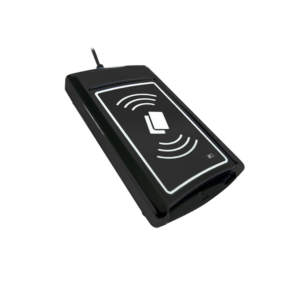Table of Contents
ToggleIntroduction
Radio Frequency Identification (RFID) is a pioneering wireless communication technology that leverages radio waves to detect, read, and write data on targeted objects, eliminating the need for mechanical or optical contact between the identification system and the target. RFID card readers bridge the technology gap by enabling wireless communication with RFID electronic tags via antennas, facilitating the retrieval or storage of tag identification codes and stored data seamlessly. These readers stand out due to their capability to discern moving objects and read multiple tags concurrently. RFID card readers are available in common forms such as fixed and handheld types.

Primary Functions of RFID Card Readers
RFID card readers perform several critical functions: reading information stored in RFID electronic tags, writing data to these tags, and modifying the information contained within them. A typical RFID system is comprised of an RFID card reader, an antenna, and RFID electronic tags. The design of the antenna significantly influences the performance of an RFID reader, affecting factors such as the reading distance. This distance is further influenced by the power consumption of the reader module, the antenna gain, the tag size, and environmental conditions. RFID card readers find applications in various industries, including logistics distribution, smart retail, manufacturing management, apparel enterprise management, anti-counterfeiting, traceability, and asset management.
Production Management
In production management, the quick detection capabilities of RFID card readers are invaluable. They ensure that the types and quantities of goods in boxes are consistent, providing a reliable foundation for quality tracing. This capability is crucial in manufacturing settings where accuracy and efficiency are paramount. By automating the verification process, RFID readers help in maintaining production standards and ensuring that discrepancies are identified and addressed promptly.
Warehouse Management
When it comes to warehouse management, RFID card readers offer notable advantages due to their extensive reading range. Using handheld RFID readers, workers can swiftly walk between containers and collect detailed information about the goods. This streamlined process enables a more efficient and less labor-intensive inventory management system. The ability to read multiple tags simultaneously means inventory checks can be completed rapidly, reducing downtime and improving overall operational efficiency. This technology proves especially beneficial in large warehouses where manual tracking would otherwise be cumbersome and slow.
Store Management
In retail store management, RFID card readers facilitate the efficient and accurate inventory of displayed and stored goods. Staff can use RFID readers to quickly inventory items and compare the collected data with platform records to manage stock replenishment accurately. During the receiving process, RFID technology allows staff to scan the contents of boxes without opening them, making the check-in process faster and minimizing the risk of errors. This efficient handling of stock not only saves time but also enhances the accuracy of inventory data, ensuring that store operations run smoothly and customer demands are met promptly.
Anti-Counterfeiting and Traceability
RFID card readers play a crucial role in anti-counterfeiting and traceability efforts. Each RFID tag can carry unique identification information that is difficult to replicate, helping to ensure the authenticity of products. In industries where product integrity is essential, such as pharmaceuticals and luxury goods, RFID technology provides a robust solution for tracking and verifying products. The ability to modify and update data on tags allows for real-time tracking of items through the supply chain, enhancing traceability and transparency from manufacturing to the end consumer.
Asset Management
Managing assets efficiently is another significant application of RFID card readers. In sectors like healthcare, construction, and corporate environments, tracking the location and status of assets is critical. RFID readers can swiftly read multiple tags attached to various assets, providing real-time data on their whereabouts and conditions. This capability reduces the time spent on manual checks and helps in maintaining accurate records of asset utilization, maintenance schedules, and inventory levels. The comprehensive data captured by RFID systems aids in better decision-making and resource allocation.
Conclusion
RFID technology represents a significant advancement in data capture and management, offering wireless, contactless reading, writing, and modification of information stored on electronic tags. The technology’s versatility is evident in its application across various domains, from fixed and handheld readers to extensive production, warehouse, and retail management scenarios. RFID card readers enhance production management by providing a reliable basis for quality tracing, improve warehouse efficiency through rapid inventory processing, and streamline store management by reducing operational time and errors. Additionally, their role in anti-counterfeiting and asset management underscores their importance in ensuring product authenticity and efficient resource management. As RFID technology continues to evolve, its potential to enhance operational efficiency, accuracy, and security across multiple sectors becomes increasingly apparent.
